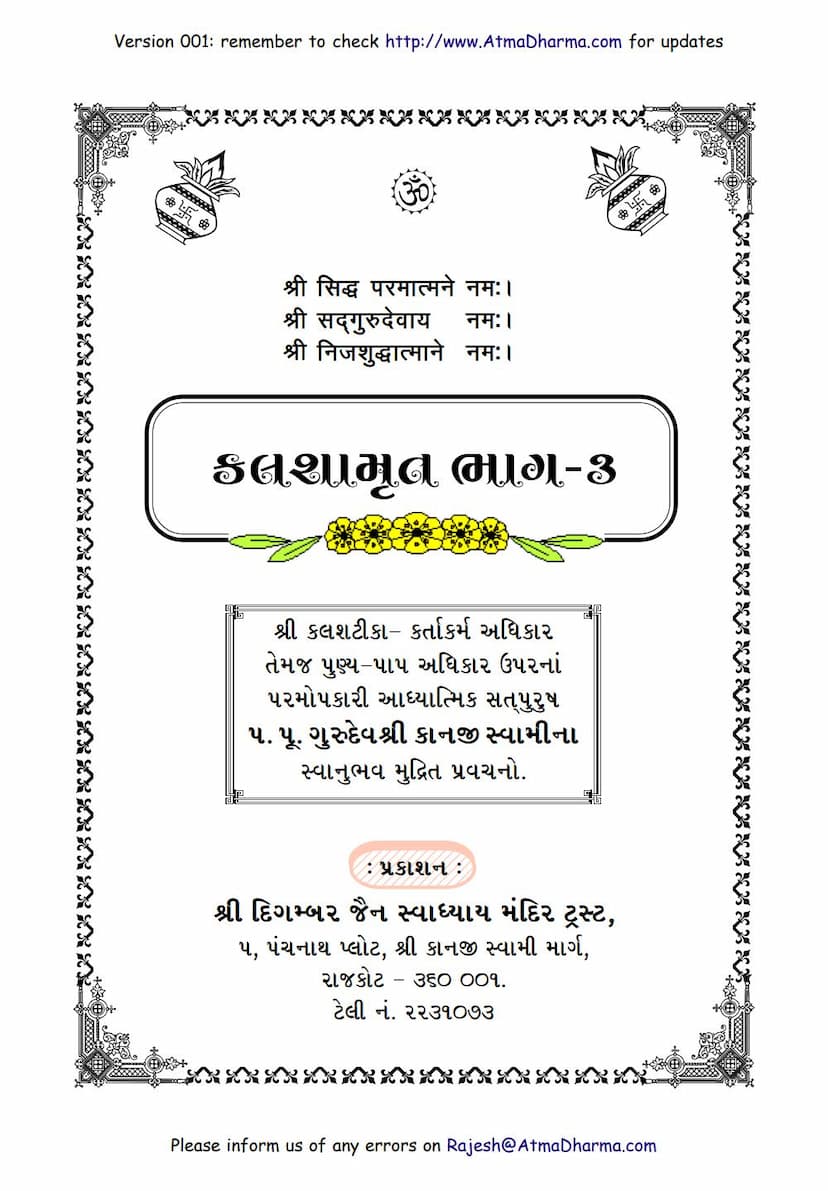Kalashamrut Part 3
Added to library: September 2, 2025

Summary
Based on the provided text, here's a comprehensive summary of "Kalashamrut Part 3" by Kanjiswami, focusing on the key themes and arguments presented in the translated verses and explanations:
Title: Kalashamrut Part 3 Author: Kanjiswami Publisher: Digambar Jain Swadhyay Mandir Trust, Rajkot, India Catalog Link: https://jainqq.org/explore/008258/1
Overall Theme:
The text is a collection of Kanjiswami's spiritual discourses (pravachans) based on the Jain scriptures, particularly focusing on the philosophical concepts of "Karta-Karma Adhikar" (Agency and Action) and "Punya-Papa Adhikar" (Merit and Demerit). The overarching theme, consistent with Kanjiswami's teachings, is the ultimate nature of the soul as pure, detached, and inherently blissful consciousness, and the path to realizing this true self by distinguishing it from karmic actions and worldly attachments.
Key Concepts and Arguments:
-
The Soul (Atma) as Pure Consciousness:
- The core message emphasizes the soul's intrinsic nature as pure, unchanging, and blissful consciousness (Shuddha Chaitanya Swarup). This soul is described as "anant shakti sampanna" (possessing infinite powers) and "anant shuddha chidanand prabhu" (an infinite bliss, consciousness-filled Lord).
- The soul is presented as existing independently of external factors and even internal modifications. The true self is beyond the concepts of birth and death, actions and their results, and is ultimately beyond all worldly descriptions and categories.
-
Critique of Ritualistic and External Practices (Karma Kanda):
- A significant portion of the text critiques the reliance on external rituals, austerities (vrat, tapas), charity (daan), worship, and even certain forms of outward religious conduct (like adhering to specific rules of conduct for monks - achara).
- These external practices, even those considered "shubh" (auspicious or meritorious), are often described as "vikar" (modifications), "raaga" (attachment/passion), "mithyatva" (false belief/delusion), and ultimately "bandh ka karan" (causes of bondage).
- The teachings strongly distinguish between the form of religious practice (dravya-ling) and the essence of spiritual realization (bhava-ling). Kanjiswami stresses that outward actions, without the inner realization and detachment, do not lead to liberation.
-
Rejection of Dualistic Views (Naya Paksha):
- The text extensively discusses the concept of "naya" (viewpoints or perspectives) in Jain philosophy, particularly contrasting "dravyarthik naya" (viewpoint of substance) and "paryayarthik naya" (viewpoint of modes/occurrences).
- While both perspectives are acknowledged as existing, the ultimate goal is to transcend all dualistic viewpoints and conceptual frameworks (like "bound vs. unbound," "pure vs. impure," "good vs. bad"). Even the intellectual understanding of the soul as "shuddha" (pure) or "akhand" (undivided) is described as a conceptual viewpoint ("paksha") that must eventually be transcended.
- The true realization ("anubhav") is beyond all concepts and intellect ("nirvikalpa").
-
The True Path (Moksha Marg):
- The path to liberation (moksha) is presented as a direct inner realization of the soul's true nature. This is achieved by focusing inward, contemplating the soul's inherent purity, oneness, and bliss, and detachment from all external and internal modifications (vikar).
- The key is to cease identifying with the modifications of the soul (like raaga, dvesha, even the intellectual understanding of "shuddha") and to rest in the unchanging, eternal substance of the soul. This is described as "Atma Anubhav" or "Swa-anubhav."
- The ultimate goal is "nirvikalpa samadhi" (equipoise beyond all conceptual thought) and experiencing the soul's inherent "Anand" (bliss).
-
Critique of External Religious Practices as Causes of Bondage:
- Practices like fasting (upavasa), austerities, charity, public rituals, and adherence to external religious symbols (like nakedness for monks or specific dress codes for laypeople) are repeatedly characterized as "raaga" (passion), "vikara" (modifications), and ultimately "bandh ka karan" (causes of bondage).
- The text argues that even "shubh bhav" (auspicious emotions or good deeds) like daan and vrat, when motivated by attachment and considered as the means to liberation, become a hindrance and a cause of further bondage. True liberation comes from realizing the inherent purity and freedom of the soul, not from performing actions to achieve it.
-
Emphasis on Inner Realization (Anubhav):
- The emphasis is consistently on direct, inner experience and realization of the soul's true nature. This experience is described as "anubandh," "anubhav," and "samadhi."
- External actions, however virtuous, are seen as mere shells or means, not the end goal itself. The true "dharma" lies in the inner realization of the soul's inherent state.
-
The Nature of "Karta-Karma" (Agency and Action):
- The "Karta-Karma Adhikar" section clarifies that the soul, in its pure essence, is not the doer of actions, especially not karmic actions or external physical actions.
- The soul is the witness (gyata-drushta), and the modifications (like raaga, dvesha, even virtuous thoughts like "I am pure") are considered either external or transient states, not the soul's inherent nature. The soul's true nature is beyond action and agency.
-
The Role of Knowledge and Discrimination:
- True knowledge ("gyan") is presented as the key. It's not just intellectual knowledge but the direct realization of the soul's nature.
- The ability to discriminate between the eternal soul and its transient states (vikar, karma) is crucial. This discrimination, when deepened, leads to detachment from the ego and the realization of the soul's true self.
In essence, Kalashamrut Part 3, as presented in these discourses, guides the listener/reader away from external religious performances and towards an introspective journey of realizing the soul's intrinsic nature. The core message is that true liberation comes not from performing actions, but from the direct, unwavering realization of the soul's pure, unattached, and blissful consciousness, which transcends all dualities and karmic processes.